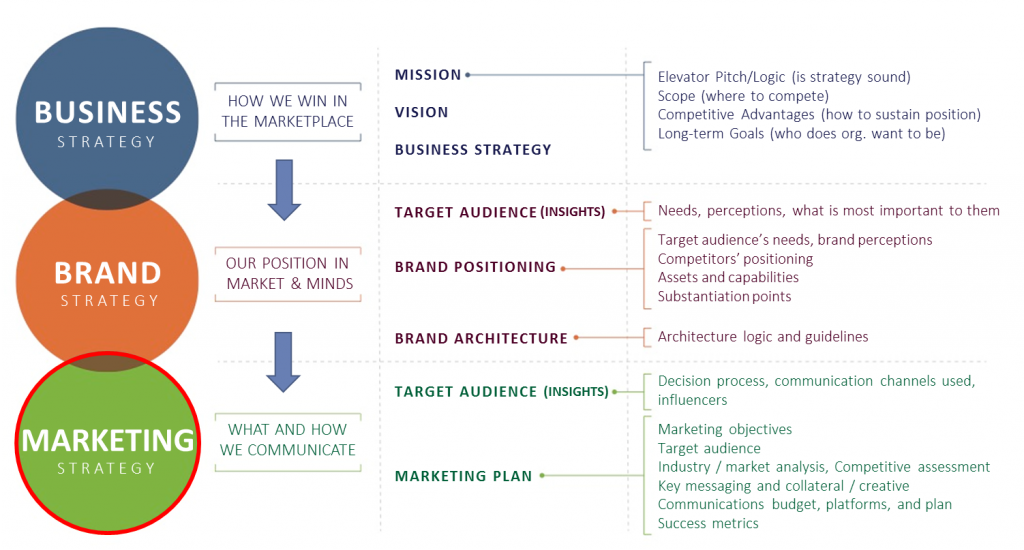As strategic marketers, we recognize the integral ways that the marketing function drives business growth – from identifying the right target audience to developing a differentiated offer to communicating that offer in a compelling way.
However, we are practicing in a time of increasing scrutiny over the value of marketing investments – especially when a material portion of marketing dollars is deemed “wasted”1 and when the majority of marketing leaders still struggle to prove the return on their investments.2
For these reasons, it is critical for marketing leaders to periodically assess (or dare I say, audit) the effectiveness of their company’s marketing overall – from marketing strategy to organization to outcomes. Here is a four-step approach that can help.
- Ensure alignment of business, brand, and marketing strategy
- Evaluate the marketing organization (i.e. are we organized to win?)
- Pressure-test the marketing processes (i.e. how can we work smarter?)
- Assess the marketing outcomes (i.e. are we achieving the desired business results?)
#1: Ensure alignment of business, brand, and marketing strategy
The most effective marketing strategy (i.e. what and how we communicate) is founded upon a clear understanding and crisp articulation of an organization’s business strategy (i.e. how we will win) and brand strategy (i.e. our position and offer in the marketplace). Otherwise, marketing priorities and investments are more likely to be “off strategy” or “off brand.” Two critical questions can help to confirm this alignment.
- Is our desired position in the marketplace and people’s minds consistent with how the company aims to grow?
- Are we communicating an offer to a target audience that is consistent with our desired position in the marketplace and people’s minds?
Here is a more detailed visualization of this framework to help marketers ensure the alignment of their business, brand, and marketing strategy.
#2: Evaluate the marketing organization (i.e. are we organized to win?)
Following strategy alignment comes a review of the organization that must deliver on that marketing strategy. The most important question is whether the marketing group is structured in the optimal way to grow the business and achieve the organization’s desired future state. Here are some questions to stimulate thinking on the optimal organization design:
- Where does the business overall make its money and where is it seeking growth?
- What must marketing “get right” to advance and accelerate the business?
- What are the marketing organization’s gaps or “pain points” today?
- Is accountability for performance clearly assigned?
- How will the requirements of the business and the marketing organization change in the next 3-5 years?
An example of organizational priorities comes from Dunkin’ Brands. Recognizing the critical importance of attracting and supporting exceptional franchisees, Dunkin’ Brands touts its above-average organizational investments as a growth driver and point of difference relative to competitors. The company supports franchisees with an extensive support team of relevant experts, such as a Franchising Executive, Real Estate Development Manager, Construction Manager, Operations Manager, Field Marketing Manager, and Training Manager. The success of Dunkin’ Brands depends on the success of its channel partners – and Dunkin’ Brands has designed and invested in its organization to support that strategy.
#3: Pressure-test the marketing processes (i.e. how can we work smarter?)
Process mapping is rarely people’s favorite marketing assessment exercise. But it will almost always surface opportunities to conduct specific marketing activities more efficiently and effectively, which can result in fewer meetings, more time to focus on the “big stuff,” and ultimately a healthier business. Here are some key questions to help guide an evaluation of marketing processes:
- Are the objectives, inputs, and deliverables of our key current processes clear? If no, why not?
- What are the key internal drivers of our marketing processes (e.g. annual budgeting, customer meetings)?
- How well do our key marketing processes align with the timelines of our key customers?
General Motors and General Electric both exemplify a robust orientation towards marketing process improvements to grow the business. General Motors makes process improvement a fun competition with rewards, regularly hosting process improvement contests among its employees. Not only do the competitions result in more efficient and effective marketing activities, but the contests also support a culture that actively seeks marketing process improvements. And General Electric actively engages its customers, inviting key accounts to help with marketing process optimization that benefits the customers and General Electric: “We are letting our customers prioritize our efforts … to improve our processes. We’re using world-class tools and driving visibility of data to help our customers compete and win.”
#4: Assess the marketing outcomes (i.e. are we achieving the desired business results?)
Finally, we must ensure that we are achieving the right business outcomes – the key word being “business” – because our measures of success must ultimately support improved business performance. When reviewing marketing metrics and outcomes, the first consideration is whether current metrics are the right ones, and the second consideration is how well we are performing against those measures.
A useful litmus test for marketing metrics is whether the set of metrics is more focused on marketing activities preceding a purchase (e.g. traffic, ad copy scores, brand awareness) or following a purchase (e.g. total sales, household penetration, Net Promoter Score). Consumer Packaged Goods companies like P&G and Kimberly-Clark exemplify the practice of ensuring that marketing metrics are more focused on business performance than tracking pre-transaction marketing activities.
Conclusion
Marketing can and should play a leading role in growing a business and delivering value from its investments. And a thoughtful assessment and optimization of overall marketing effectiveness will help, beginning with the alignment of business, brand, and marketing strategy, followed by an evaluation of the marketing organization, its key processes, and its business outcomes.
Sources:
1 BCG, “No Shortcuts: The Road Map to Smarter Marketing,” 2010
2 “The CMO Survey,” McKinsey, American Marketing Association, Duke University, February 2015



